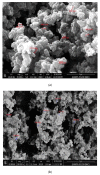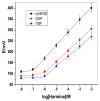Solid-Contact Potentiometric Sensors Based on Main-Tailored Bio-Mimics for Trace Detection of Harmine Hallucinogen in Urine Specimens
- PMID: 33435196
- PMCID: PMC7826799
- DOI: 10.3390/molecules26020324
Solid-Contact Potentiometric Sensors Based on Main-Tailored Bio-Mimics for Trace Detection of Harmine Hallucinogen in Urine Specimens
Abstract
All-solid-state potentiometric sensors have attracted great attention over other types of potentiometric sensors due to their outstanding properties such as enhanced portability, simplicity of handling, affordability and flexibility. Herein, a novel solid-contact ion-selective electrode (SC-ISE) based on poly(3,4-ethylenedioxythiophene) (PEDOT) as the ion-to-electron transducer was designed and characterized for rapid detection of harmine. The harmine-sensing membrane was based on the use of synthesized imprinted bio-mimics as a selective material for this recognition. The imprinted receptors were synthesized using acrylamide (AA) and ethylene glycol dimethacrylate (EGDMA) as functional monomer and cross-linker, respectively. The polymerization process was carried out at 70 °C in the presence of dibenzoyl peroxide (DBO) as an initiator. The sensing membrane in addition to the solid-contact layer was applied to a glassy-carbon disc as an electronic conductor. All performance characteristics of the presented electrode in terms of linearity, detection limit, pH range, response time and selectivity were evaluated. The sensor revealed a wide linearity over the range 2.0 × 10-7-1.0 × 10-2 M, with a detection limit of 0.02 µg/mL and a sensitivity slope of 59.2 ± 0.8 mV/hamine concentration decade. A 40 mM Britton-Robinson (BR) buffer solution at pH of 6 was used for all harmine measurements. The electrode showed good selectivity towards harmine over other common interfering ions, and maintained a stable electrochemical response over two weeks. After applying the validation requirements, the proposed method revealed good performance characteristics. Method precision, accuracy, bias, trueness, repeatability, reproducibility, and uncertainty were also evaluated. These analytical capabilities support the fast and direct assessment of harmine in different urine specimens. The analytical results were compared with the standard liquid chromatographic method. The results obtained demonstrated that PEDOT/PSS was a promising solid-contact ion-to-electron transducer material in the development of harmine-ISE. The electrodes manifested enhanced stability and low cost, which provides a wide number of potential applications for pharmaceutical and forensic analysis.
Keywords: hallucinogen; harmine; imprinted polymers; ion-selective membrane sensors; poly(3,4-ethylenedioxythiophene) (PEDOT); solid-contact.
Conflict of interest statement
The authors declare no conflict of interest.
Figures







Similar articles
-
Novel Carbon/PEDOT/PSS-Based Screen-Printed Biosensors for Acetylcholine Neurotransmitter and Acetylcholinesterase Detection in Human Serum.Molecules. 2019 Apr 18;24(8):1539. doi: 10.3390/molecules24081539. Molecules. 2019. PMID: 31003551 Free PMC article.
-
Single-Piece Solid Contact Cu2+-Selective Electrodes Based on a Synthesized Macrocyclic Calix[4]arene Derivative as a Neutral Carrier Ionophore.Molecules. 2019 Mar 6;24(5):920. doi: 10.3390/molecules24050920. Molecules. 2019. PMID: 30845715 Free PMC article.
-
Multi-analyte biochip (MAB) based on all-solid-state ion-selective electrodes (ASSISE) for physiological research.J Vis Exp. 2013 Apr 18;(74):50020. doi: 10.3791/50020. J Vis Exp. 2013. PMID: 23628944 Free PMC article.
-
Synthesis and electrochemical sensing application of poly(3,4-ethylenedioxythiophene)-based materials: A review.Anal Chim Acta. 2018 Aug 31;1022:1-19. doi: 10.1016/j.aca.2018.02.080. Epub 2018 Mar 14. Anal Chim Acta. 2018. PMID: 29729729 Review.
-
Ion-Selective Electrodes with Solid Contact Based on Composite Materials: A Review.Sensors (Basel). 2023 Jun 23;23(13):5839. doi: 10.3390/s23135839. Sensors (Basel). 2023. PMID: 37447689 Free PMC article. Review.
Cited by
-
Diffusion-Limited Processes in Hydrogels with Chosen Applications from Drug Delivery to Electronic Components.Molecules. 2023 Aug 7;28(15):5931. doi: 10.3390/molecules28155931. Molecules. 2023. PMID: 37570901 Free PMC article. Review.
-
A systematic review of sensors to combat crime and routes to further sensor development.Front Chem. 2025 Jun 12;13:1568867. doi: 10.3389/fchem.2025.1568867. eCollection 2025. Front Chem. 2025. PMID: 40575464 Free PMC article. Review.
-
Low-cost potentiometric paper-based analytical device based on newly synthesized macrocyclic pyrido-pentapeptide derivatives as novel ionophores for point-of-care copper(ii) determination.RSC Adv. 2021 Aug 18;11(44):27174-27182. doi: 10.1039/d1ra04712d. eCollection 2021 Aug 9. RSC Adv. 2021. PMID: 35480650 Free PMC article.
-
All-Solid State Potentiometric Sensors for Desvenlafaxine Detection Using Biomimetic Imprinted Polymers as Recognition Receptors.Polymers (Basel). 2022 Nov 9;14(22):4814. doi: 10.3390/polym14224814. Polymers (Basel). 2022. PMID: 36432940 Free PMC article.
-
Characterization of Some "Hashish" Samples in the Egyptian Illicit Trafficking Market Using a Thermal Separation Probe and Gas Chromatography-Mass Spectrometry.ACS Omega. 2023 Jul 5;8(28):25378-25384. doi: 10.1021/acsomega.3c02809. eCollection 2023 Jul 18. ACS Omega. 2023. PMID: 37483228 Free PMC article.
References
-
- Southon I.W., Buckingham J., editors. Dietzonary of Alkaloids. Chapman and Hall; London, UK: 1989. p. 487.
-
- Shaheen H.A., Issa M.Y. In vitro and in vivo activity of Peganum harmala L. alkaloids against phytopathogenic bacteria. Sci. Hortic. 2020;264:108940. doi: 10.1016/j.scienta.2019.108940. - DOI
MeSH terms
Substances
Grants and funding
LinkOut - more resources
Full Text Sources
Other Literature Sources

